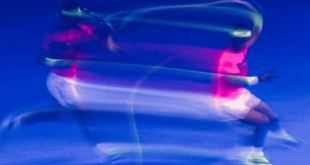When NASA released images of Sakaka from the International Space Station in December 2020, you could have been forgiven for thinking you were staring at the moon.
The weathered tops of the ancient buildings in the Saudi Arabian oasis town were almost indistinguishable from the rutted land and it was only on closer inspection you could see signs of modernity.
Sakaka, once part of a caravan route in the country’s far north, is home to the kingdom’s emerging renewable energy industry, and this explains the shards of sharp light reflecting from a field of solar panels.
The $320m (£243m) project, mainly funded by private investment, was announced through state channels in 2018, as it attempted to bring 400 new jobs to the remote and impoverished Al Jouf region.
When the plant opened three years later, Crown Prince Mohammed bin Salman described the development as a “pivotal moment” for Saudi Arabia’s renewable plans, with seven similar facilities to follow.
Sakaka is central to Vision 2030, Salman’s attempt to bring sustainability as Saudi Arabia diversifies away from its reliance on oil.
Football forms part of the same brochure. Saudi Arabia says it is opening up, it wants tourism and it will host the World Cup in 2034.

GO DEEPER
Saudi Arabia to host 2034 World Cup – what does it mean for wider world of football?
Since early last year, Saudi Arabia’s Public Investment Fund (PIF) has been the majority owner of four of the country’s Saudi Pro League teams — Al Ahli, Al Hilal, Al Ittihad and Al Nassr — and contributed much of the near $1bn (£760m) blow-out on foreign players in 2023.
While 2023 will be remembered as the year Cristiano Ronaldo (Al Nassr), Neymar (Al Hilal), Karim Benzema (Al Ittihad) and Jordan Henderson (Al Ettifaq; he terminated his contract in January and joined Ajax) left Europe for lucrative contracts in the Saudi Pro League, the transfer outlay in 2024 has been less extravagant, with total spending coming in at around $250m (£190m).
Contributing towards that figure was the somewhat modest fee of $250,000 (£190,000) that took Brad Young at the end of the window from Cymru League champions The New Saints (TNS) to Al Orobah, a Saudi Pro League side who are based in Sakaka.

Brad Young was a surprise Saudi signing (Ben Roberts Photo/Getty Images)
It might be argued that any boom town requires a sporting focus to bring out its residents and this contributes towards why Young, from Birmingham, will trade playing for a borderland club between Wales and England, for one that is a relatively short drive away from Saudi Arabia’s frontier with Iraq.
Al Orobah’s recruitment approach over the last few months acts as a convenient entry point for some analysis of the Saudi Pro League in 2024.
While many of Saudi Arabia’s top clubs are stacked with foreigners on long-term deals, that was not the case for Al Orobah since their promotion in May, nor for Al Qadsiah, another promoted club, who are based in Khobar just south of Dammam, where Steven Gerrard manages Al Ettifaq on the east coast of Saudi Arabia.
Effectively, both Al Orobah and Al Qadsiah have been able to start again. Al Orobah began the summer by releasing each of their eight foreign players, including Vurnon Anita, who earlier in his career played 153 games for Ajax and 155 games for Newcastle United. Anita is 35 now and Al Orobah wanted fresher options.
To get ready for the top flight, they have hired a Portuguese manager in Alvaro Pacheco, who lasted just four games in his previous post with Vasco da Gama in Brazil, as well as 10 new foreign signings, including former West Ham United captain Kurt Zouma on loan, whose move to United Arab Emirates collapsed earlier in the window, and Johann Berg Gudmundsson, who was out of contract after leaving Burnley.
Under new rules, clubs are allowed to sign eight non-Saudi players without an age limit as well as two non-Saudi players born in 2003 or after, “in order to boost investment in young talent” according to a statement published by the Saudi Pro League in December 2023.
Young, born in January 2003, just about falls into this category. Four years ago, while on the books of Aston Villa, he was recovering in a Birmingham hospital having been stabbed three times after resisting a robbery attempt in a Solihull park. Following his release from Villa last summer, he became the Cymru Premier League’s Golden Boot winner after scoring 22 goals in 25 games for TNS.
Though it might seem strange he would attract interest from arguably the most ambitious new league in the world, middle men representing Saudi clubs were in attendance at Llanelli’s Stebonheath Park in March when the Wales C team beat their English equivalents 1-0. Though Young did not feature in that game, it showed how far some of the Saudi clubs were willing to look.

Iceland international Gudmundsson swapped Burnley for Sakaka (Julian Finney/Getty Images)
When Young scored twice on his European debut for TNS in their 3-0 Champions League first-qualifying-round, first-leg victory over Montenegro’s FK Decic, Saudi attention ramped up.
Yet Young would not be the first Saudi import from a Welsh club in the summer of 2024. That honour went to Andy Firth, a 27-year-old goalkeeper from Connah’s Quay Nomads, formerly with Liverpool and Rangers, who moved to Al Ettifaq in June to take up a coaching position, working beside Gerrard.
Al Qadsiah re-shaped its squad with some eye-catching signings, albeit without spending quite as much money as some agents thought they might.
This time last year, another Liverpool legend Robbie Fowler was in charge of Al Qadsiah but he was sacked with the team top of the league. His replacement Michel steered the team to promotion, after which — like Al Orobah — the club ditched each of its foreign players and replaced them with eight new signings plus one “2003-born” recruit.
Former Arsenal striker Pierre Emerick-Aubameyang and Real Madrid’s Champions League-winning defender Nacho were the biggest names recruited by Al Qadsiah, which is not PIF-owned but is bankrolled by oil company Aramco. But Al Qadsiah’s most expensive buy was Ezequiel Fernandez from Boca Juniors for $23million (£17.5m), an emerging midfielder who featured for Argentina at the Olympics.
Agents in Europe had anticipated that the window in Saudi Arabia was going to be a lot cooler than last summer for one logical reason: there was a willingness to spend but ultimately, most of the teams were already well stocked with foreign players and were having difficulties offloading. Some clubs had foreign players returning from loan spells elsewhere. This all contributed to clubs having to sell before they could enter the market.
Al Ahli, one of the two big teams in Jeddah, for example, had to find a buyer for former Newcastle United forward Allan Saint-Maximin before they could bring anyone in. Once he was sent on loan to Fenerbahce, it allowed them to redouble their efforts to sign Ivan Toney from Brentford.
Across the city, as soon as Portuguese winger Jota was sold to Rennes at a £15m loss, Al Ittihad were able to get Steven Bergwijn from Ajax, a move which prompted Dutch coach Ronald Koeman to “close the book” on the 26-year-old’s international career because of fears over the competitiveness of the Saudi league.

Bergwijn may have jeopardised his international career by moving to Saudi (John Macdougall/AFP/Getty Images)
Meanwhile, Riyadh side Al Shabab spent most of the summer trying to sell Senegalese forward Habib Diallo, a record signing of £20million from Strasbourg in 2023. Diallo’s story acts as a case study for the challenges Saudi clubs are having around money. Though Al Shabab wanted to offload the player, his salary limited the number of potential European buyers unless they continued to contribute a substantial percentage of his wages. In the end, Diallo stayed in the country by signing a loan deal with Damac. This allowed Al Shabab to complete the purchase of Daniel Podence from Wolverhampton Wanderers.
Of the other European players to arrive in Saudi Arabia this summer, perhaps only Mohamed Simakan and Joao Cancelo are somewhere near their peak. Simakan, a 24-year-old defender previously with RB Leipzig, moved to Al Nassr for €35m (£29.5m), where he was joined by Brazilian Angelo in a deal that allowed Chelsea to make a £5.5m profit on a winger who never played for the club.
Cancelo’s €25m (£21m) transfer to Al Hilal from Manchester City was not the biggest deal completed by the Riyadh club, however, who signed Brazilian forward Marcos Leonardo from Benfica for €40m (£33.7m). At the other end of the scale, former Manchester United defender Chris Smalling agreed to leave AS Roma for Al Fayha on a free transfer.
It is suspected that the summer of 2026 will see the next significant tranche of spending because lots of foreign players will reach the end of their three-year deals, though next summer there could be some upwardly-mobile promoted clubs attacking the market again, in a similar vein to Al Orobah and Al Qadsiah.
A likely contender is Neom SC, a second-division club previously called Al Suqoor, who changed their identity late last year in preparation for a move to the futuristic city being built in the desert by the same name at an estimated cost of $1.5trillion.
Amongst Neom’s signings this summer was Ahmed Hegazy, the defender once of West Bromwich Albion. It remains to be seen whether his Egyptian international team-mate Mohamed Salah will join him in Saudi Arabia over the coming year or two.
The kingdom can certainly afford Salah, but it is a question of when a Saudi Pro League club can make the move work, and whether he relishes playing at a level where promoted clubs are fishing in Welsh streams.

GO DEEPER
Steven Gerrard looks trapped in Saudi football’s gilded cage
(Top photos: Pierre-Emerick Aubameyang and Brad Young; Getty Images)
Source link
 meganwoolsey Home
meganwoolsey Home



